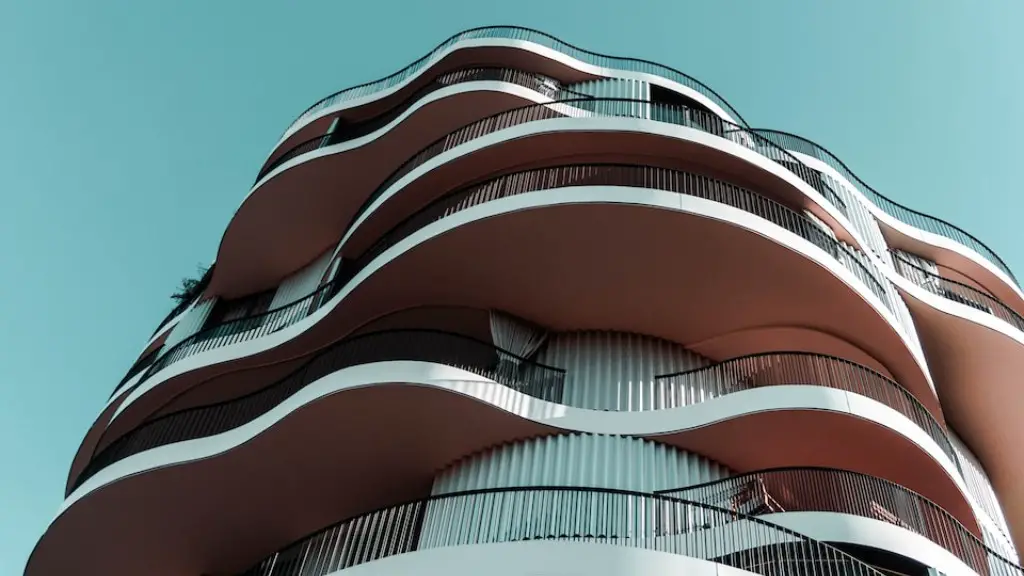Frank Lloyd Wright is widely regarded as one of the most influential architects of the twentieth century. He is credited with establishing the Prairie style of architecture, which was characterized by its horizontal lines, low-pitched roofs, overhanging eaves, bands of windows and other structural details. Wright’s vision of architectonic beauty extended beyond the exterior of a building and also to its interior, often making extensive use of natural light and organic materials. Beyond the Prairie style, Wright also developed and popularized the Usonian style of architecture, which combined function and aesthetics in residences that were often designed to be low-cost, sustainable and environmentally-friendly.
Wright also used “organic architecture”, a term which he coined to describe the idea of a building existing harmoniously with its environment. He believed that a building should not be a stand-alone structure but should instead blend in with the landscape. To achieve this, he often used bold colors, dramatic shapes and geometric forms to create a visually stimulating environment. He was also a pioneer in the use of steel and reinforced concrete, occasionally using pre-fabricated components in his designs. He also incorporated interior elements, such as woodwork, furnishings and decor, to create a whole that was greater than the sum of its parts.
Frank Lloyd Wright’s influence on the world of architecture is undeniable. He was a major proponent of modernism, which was characterized by its open plan layout, streamlined forms and the integration of natural light. Wright also made use of strong geometric shapes, often placing circles and rectangles at the center of his designs. He believed that every element of his architecture should work together as a unified piece, with every line, shape, texture and material connecting to form a harmonious whole.
Frank Lloyd Wright’s style of architecture had a profound effect on how buildings were designed and constructed. He was a master of integrating form and function, often creating buildings that were both aesthetically stunning and technologically advanced. His use of natural light, organic materials and pre-fabricated units helped revolutionize the design of residential and commercial buildings. Additionally, his approach to architecture was a major influence on subsequent generations of architects.
Impact of Frank Lloyd Wright’s Style of Architecture
Frank Lloyd Wright’s style of architecture had a profound impact on the built environment. His use of open plans, dramatic shapes and integration of natural light helped revolutionize the design of residential and commercial buildings. Modernism, which was characterized by its open plan layout, streamline forms, and integration of natural light, is seen as a direct result of his influence. His architecture played a major role in influencing subsequent generations of architects and he is still held up as one of the most influential and inspirational figures in the field.
Wright was also a pioneer in the use of steel and reinforced concrete, occasionally using pre-fabricated components in his designs. This made his buildings more durable and cost-effective. The use of such materials allowed Wright to create a sense of strength and durability, while also adding a touch of beauty to the industrial aesthetic of his designs. Additionally, Wright was one of the first architects to make use of glass in buildings, often using it to create curved structures that let in light and dramatically altered the way in which rooms and buildings were illuminated.
Frank Lloyd Wright – Legacy of Innovation
Frank Lloyd Wright’s legacy is remembered as one of innovation, creativity, and beauty. His unique style of architecture, which blended function and aesthetics to create harmonious works of art, is still being studied and admired today. His use of primitive geometric shapes, bold colors, and strong architecture lines were revolutionary, and heavily influenced subsequent generations of architects. He was also a pioneer in the use of steel, reinforced concrete and glass, materials which he used to create buildings that were both aesthetically pleasing and technologically advanced.
Wright’s influence on the world of architecture is undeniable, and his legacy lives on to this day. His ideas on organic architecture, modernism, and his use of glass and pre-fabricated components continue to shape the way in which we design, construct and inhabit buildings. His vision of architectonic beauty, which sought to create harmonious works of art that blended with the natural environment, is still held up as one of the greatest examples of modern design.
Impactful Projects of Frank Lloyd Wright
Frank Lloyd Wright’s portfolio of works contain some of the most iconic architectural structures in the world. He was responsible for designing the iconic Robie House in Chicago, the Imperial Hotel in Tokyo, and the world’s first modern skyscraper, the Price Tower in Bartlesville, Oklahoma. He is also credited with designing the Guggenheim Museum in New York City, one of his most well-respected works. Beyond buildings, Wright also designed furniture, textiles, and other household items, which often feature his signature style.
Wright’s works have been studied and admired by architects and artists around the world. He designed numerous iconic buildings, breaking contemporary conventions and setting the foundation for modernist movements to come. His iconic projects have been reproduced and copied across the globe, and his pioneering techniques still have an impact on contemporary architects.
Frank Lloyd Wright – Inspiration for Others
Frank Lloyd Wright’s work has been an inspiration for generations of architects, designers, and artists. His pioneering use of geometry and forms, as well as his eye for detail, set him apart from other architectural figures. His commitment to organic architecture was seen as revolutionary and his use of glass, steel, and reinforced concrete inspired many subsequent generations of architects. He was a master of integrating form and function, often creating buildings that were both aesthetically stunning and technically advanced.
His influence on the world of architecture cannot be overstated, and his iconic projects continue to influence modern architects. His use of primitive shapes, organic materials, and innovative construction methods has had a lasting impact on the built environment. His works are still being studied and admired today, and his name will continue to be held in high regard for generations to come.
Influence of Frank Lloyd Wright On Modern Architecture
Frank Lloyd Wright was a major proponent of modernist architecture. His organic approach to design, his emphasis on the use of geometry and forms, and his dedication to detail helped shape the direction of modern architecture. His iconic projects have been copied and studied across the globe, and his pioneering techniques still have an impact on contemporary architects. He was a master at integrating form and function, often creating buildings that were both aesthetically stunning and technologically advanced.
His influence on the world of architecture is undeniable, and his works are still held up as exemplary examples of modern design. His use of open plans, integration of natural light and use of glass revolutionized the design of residential and commercial buildings. The influence of his ideas and techniques are still seen in the works of contemporary architects, and his legacy will continue to be admired and studied for generations to come.



